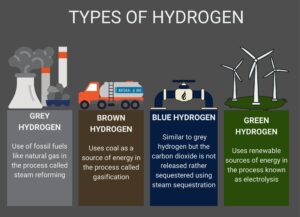by Eliza Maharjan
There is a global urgency to act against the impacts of climate change. With the recent COP 26, countries across the globe have planned to phase out fossil fuels and aim for emissions well below 1.5 degrees Celsius. It was emphasized that countries need to “phasedown” coal and support developing economies to achieve this global goal. With such urgency to reduce greenhouse gas emissions (GHGs), the transition to alternative energy was highlighted. Alternative energy thus is gaining momentum with promises to reduce our dependence on fossil fuels.
The global efforts to limit the warming to under 1.5 degrees Celsius might be possible with a boom in the alternative energy sector. Alternative energy uses renewable sources of energy such as the sun, wind, biomass, and water to generate energy. One such example of alternative energy that is new in the energy market is hydrogen. Hydrogen exists in abundance in nature in almost every living thing on Earth. However, it is not found as a standalone in nature thus it must be extracted from biomass or water
Hydrogen was used to fuel the internal combustion engines more than 200 years ago and was also used to lift balloons and airships in the past. Hydrogen as a commodity is also used in fertilizers(ammonia). Hydrogen as a source of energy is fairly new and there are numerous research and possibilities for huge investments in this sector.
What is “Green” in Green Hydrogen?
So, is hydrogen the new way of delivering clean and green energy to the Earth? The answer depends on how they are produced. Depending on the source of energy used to produce hydrogen, they can be classified into green, grey, brown, and blue.

Most of the hydrogen that is produced today is using fossil fuels which does not align with the global goal of achieving carbon neutrality. So, green hydrogen might be able to play an important role in helping the world achieve that goal.
So, how exactly is green hydrogen produced?
Green hydrogen is produced by the process known as electrolysis. Electrolysis is the process where water is split into its constituents namely hydrogen and oxygen with zero carbon emissions. Then that hydrogen is used as a fuel or stored in fuel cells for future use. Fuel cells are then used to convert the chemical energy of hydrogen to produce electricity. They are similar to batteries, but they do not need recharging and produce electricity as long as fuel is supplied. They have benefits over the traditional combustion-based technologies where the efficiencies are higher than the combustion-based technologies.
Why is green hydrogen gaining popularity?
While most hydrogen is used in the manufacturing industry, it mostly comes from fossil fuels which have high carbon emissions which is contrary to the COP goals. Green hydrogen can thus come in handy as it is deemed as a “clean” form of energy which does not emit any greenhouse gases as the by-product is simply water vapour. So, it could be a great tool for decarbonization for certain sectors.
It can also enhance the use of other renewables like solar and wind which heavily depends on the weather [1]. The availability of solar or wind largely depends on the availability of sun and wind respectively so these might not match the demand during peak seasons and times with no sun or wind. So, storing hydrogen can be used to store that energy in the long run and can be transported long distances. “Hydrogen can be stored for a long period of time, balancing the fluctuations in renewable generation” [1]. However there currently does not exist the required infrastructure nor demand for hydrogen as a source of energy [1,2] making the viability of this market solely based on future projections of growth and uptake of this technology.
Why not green hydrogen?
It is one of the most “versatile” sources of energy because of its wide range of applications ranging from transportation to the manufacturing industry and the generation of power [3]. Thus, one might think green hydrogen is one of the best sources of energy for contemporary society, but it is an energy-intensive process. Eric Bibeau, an engineering professor at the University of Manitoba believes that while it could be a great tool to decarbonize the transport and manufacturing industry, it is not the most efficient when used as a source of energy. He thinks using electricity to produce hydrogen and then turning it back into electricity sounds like an inefficient process. It has an efficiency of around 30% meaning that it is not economical in some sectors and could prove to be expensive for the end-users.
Moreover, it could be a time-consuming process where you must use vast amounts of energy to split water into H and O. Converting water into hydrogen would require an enormous input of energy and with already low usage of alternative energy in the world, there is a temptation to produce hydrogen using fossil fuels which defeats the goal of achieving carbon neutrality.
Its low density makes it harder to store and move around hydrogen [4]. There are also negative health implications if used in large amounts. It is small so it can diffuse into certain metals and cause the failure of those metals which could lead to economical losses for industries [6]. Moreover, it is also highly flammable so one must be extra cautious while handling and transporting hydrogen.
Similarly, the storage costs are high. Production and storage of fuel cells could be expensive along with the additional costs associated with the transportation of hydrogen. The electrolysers are expensive as the market for electrolysers has been small [4]. The capital-related costs might be able to lower once the technology develops in the future however energy efficiency is still a huge consideration [5]. It can be considered sustainable only if the cost element is reduced in terms of production, equipment and storage and transportation [5].
Can it be used in the Indigenous communities?
The answer is it depends. Since it could be used for the storage of electricity in the long run the remote communities might be able to reap the benefits from this energy. For the Indigenous communities which rely on diesel or have frequent outages, green hydrogen can provide storage of energy that could be used in peak times. However, the efficiencies and the high costs of production might make it uneconomical for the communities at the moment without technological advancements and measures to address the cost. Eric Bibeau mentioned that it would be beneficial to have green hydrogen in those communities as a commodity (ammonia) rather than a source of energy.
- Scita, R., Raimondi, P. P., & Noussan, M. (2020). Introduction. In M. Hafner (Ed.), Green Hydrogen: The Holy Grail of Decarbonisation? An Analysis of the Technical and Geopolitical Implications of the Future Hydrogen Economy (pp. 3–4). Fondazione Eni Enrico Mattei (FEEM). http://www.jstor.org/stable/resrep26335.3
- Department of Energy, Science and Technology. (2003). Manitoba Energy Development Initiative, Preliminary Hydrogen Opportunities Report. 1-62.
- International Energy Agency. (2019, June). The Future of Hydrogen. https://iea.blob.core.windows.net/assets/9e3a3493-b9a6-4b7d-b499-7ca48e357561/The_Future_of_Hydrogen.pdf
- Deign, J. (2020, June 29). So, what exactly is green hydrogen? Greentech Media. https://www.greentechmedia.com/articles/read/green-hydrogen-explained
- Kramer, G. J., Huijsmans, J., & Austgen, D. (2022). Clean and Green Hydrogen.
- Chandler, D.L. (2019, Feb 4). Observing hydrogen’s effects in metal. MIT News. https://news.mit.edu/2019/observing-hydrogens-effects-metal-0205

